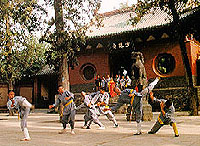|
Shaolin Monks Fight to Protect Temple's Reputation
|
| |
 Monks of China's famed Shaolin Temple, which is commonly considered the birthplace of Chinese kung fu, a unique combination of Buddhism and Chinese martial arts, have been more and more aware of safeguarding the temple's reputation by legal means.
Monks of China's famed Shaolin Temple, which is commonly considered the birthplace of Chinese kung fu, a unique combination of Buddhism and Chinese martial arts, have been more and more aware of safeguarding the temple's reputation by legal means.
"The Shaolin Temple is an important piece of cultural heritage for all human beings. To protect it, we must propose draft legislation to ensure appropriate action," said the abbot of the Temple, whose religious name is Shi Yongxin.
Located in Dengfeng County in central China's Henan Province, the Shaolin Temple was built in the foothills of the sacred Songshan Mountain in AD 495 during the Northern Wei Dynasty (386-534).
Thirty-two years later, Bodhi Dharma, an India monk, began to teach in the temple and introduced an Indian form of exercise, which is regarded as the birth of the temple's martial art tradition.
Generations of Shaolin monks have devoted themselves to enriching and improving the tradition and have gradually developed it into a complex and sophisticated system of fighting, widely recognized as "gongfu" or kung fu.
Shaolin kung fu became more famous in modern China with the cinematic debut of the movie "Shaolin Temple" over 20 years ago, and its global influence has grown since the 1970s due to its use in a wide variety of foreign films featuring actors of Chinese origin, including Bruce Lee and Jackie Chan.
In recent years, the popularity of kung fu has been accentuated by Ang Lee's Oscar-winning blockbuster "Crouching Tiger, Hidden Dragon".
To enhance protection, earlier this year, the 1,500-year-old Chinese kung fu underwent an application process to the United Nation's Educational, Scientific and Cultural Organization (UNESCO)for becoming listed as a "World Intangible Heritage."
"These days, Shaolin kung fu is misconstrued because most people barely scratch its surface and think that it is simply a martial art," said Shi Yongxin, who is also a deputy of the National People's Congress (NPC).
"Our temple is applying to UNESCO so that Chinese kung fu, not the martial arts, be listed as World Intangible Heritage," he said," because kung fu refers to Buddhist meditation and cultivation, which aims to improve one's moral qualities. Our monks practice of martial arts is one method of moral development."
Meanwhile, the local government is taking steps to place the temple and more than 600 stupas, which were built as tombs for monks during the Tang Dynasty (618-907) and the Qing Dynasty (1368-1644) at the temple and on nearby Songshan Mountain, on the United Nation's World Heritage list. The application process was initiated last year.
Shi Yongxin said that, in fact, the Songshan Shaolin Temple comprises the existing temple buildings, The Forest of Stupas, a cemetery for Shaolin monks, and a pavilion commemorating Bodhi Dharma.
"Thus, We should promote the listing of the Shaolin Temple as a whole," he said.
"And a successful application will not only help protect the endangered culture of Shaolin, but will also help to carry forward China's traditional culture," he said.
The temple is also involved in a battle to protect its name, involving the registration of "Shaolin" or "Shaolin Temple" as trademarks throughout the world.
According to figures provided by the temple, 80 unauthorized kung fu schools in China have used the name Shaolin, and more than100 businesses, including those selling cars, beer, tires, furniture, and even wire, bear the Shaolin trademark, all without consulting the temple.
A spot check conducted by the China Trademark and Patent Affairs Agency in 11 countries and regions on five continents also shows that, with the exception of Hong Kong, 117 examples of the use of the temple's name have been registered in these areas.
In 1994, the temple won a lawsuit against a company in a nearby town that was using the Shaolin name to market its product -- sausage, the first case of this type.
To further defend its reputation and interests, the temple has set up a firm, the Henan Shaolin Temple Industrial Development Ltd.Co., to protect and administer the intangible assets of Shaolin Temple, to safeguard the legitimate rights of the temple and to investigate cases of unauthorized use of the temple's name in commercial activities, said Yongxin.
In recent years, the temple applied for registration of "Shaolin" and "Shaolin Temple" as trademarks with the General Administration for Industry and Commerce of China, and similar efforts have also been stepped up in foreign countries.
To date, Shaolin Temple has registered nearly 100 items in China and has applied for registration in 68 countries since 2000,according to the abbot.
"It is our historical responsibility to protect and rejuvenate the culture of Shaolin," he said.
(Xinhua News Agency May 6, 2003)
|
|
|

